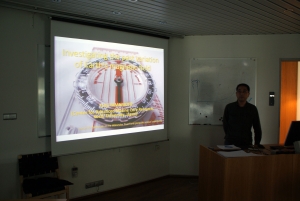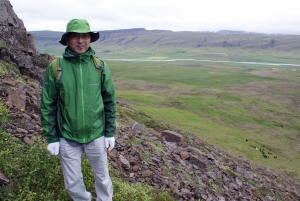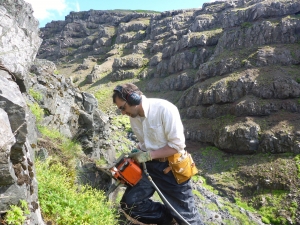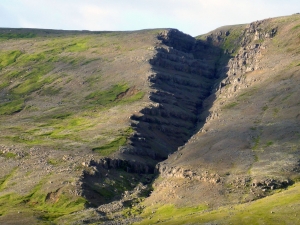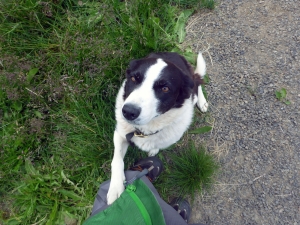I am an associate professor at the Center for Advanced Marine Core Research, Kochi University, Japan. Over the past 15 years my research has focused on the evolution of Earth’s magnetic field (the geomagnetic field) over its 4.6 billion year history. Through the ability of Iceland’s lavas to record changes in the past geomagnetic field (the paleomagnetic field) they provide a unique, but underutilized opportunity to investigate its long-term variation. A particularly interesting question that data from Icelandic lavas can answer is, ‘What was the average strength of Earth’s magnetic field (it’s paleointensity) over the past 5 million years?’.
Previous work by Japanese scientists led by Prof. Masaru Kono (emeritus), Tokyo Institute of Technology, in collaboration with Prof. Leó Kristjánsson (emeritus), University of Iceland, was conducted at a number of locations in Iceland in 1993/1994, and suitable lava sequences were chosen to address this question. Members of Prof. Kono’s group have since published paleomagnetic directions and paleointensities from samples collected in Jökuldalur and Storutjarnir (Udagawa et al., 1999; Tanaka and Yamamoto, 2016); however, samples from Suðurdalur (eastern Fjords) and Lundarháls (western Iceland) have not yet been fully investigated. I have recently begun to analyze these samples, but unfortunately the success rate of the paleointensity experiments was less than 50 percent, with less than three successful samples per lava flow for many flows. The paleointensity recorded in these lava flows is therefore not well constrained and further samples are needed to reliably reconstruct past variations in geomagnetic field strength.
With the support of the Watanabe Trust Fund, I resampled the lavas of the Lundarháls ridge in the Borgarfjörður region of western Iceland. With the help of Dr. Maxwell Brown, a research specialist in paleomagnetism at the Institute of Earth Sciences, University of Iceland, I collected at least five new samples per lava flow. Dr. Brown and I developed a working relationship during my time on a fellowship with the Japan Society for the Promotion of Science (JSPS) at the University of Liverpool Geomagnetism Laboratory in 2006-2007 and we have closely related research interests, namely investigating paleointensity.
In Prof. Kono’s original field campaign at the Lundarháls ridge 9 sequences of lavas were sampled. However, this sampling spanned two summers, with a larger field team. Therefore, I decided to concentrate on the youngest and most accessible section, Prof. Kono’s VG sequence located in the Hrafnagil gulley behind Lundur farm along the Grimsá river valley. This section was exposed through erosion by a small river, with magnificent views of the Snæfellsness volcano to the northwest and Hvalfell area to the southeast. As the lavas gently dip to the east, younger sections become exposed as you move east along the Grimsá river valley. I additionally decided to take samples from a section not previously sampled by Prof. Kono’s group, which I have called the VH section. The aim of this sampling is to extend the age coverage of the samples from Lundarháls, as VH sits stratigraphically above Prof. Kono’s sequences. I spent 11 days in the field and collected 321 cores from 30 lavas from the VG section and 43 cores from 11 lava flows from the VH section. The next step is to analyze the core samples at my home institute to determine the past direction and intensity of the geomagnetic field.
This was my first visit to Iceland. I have conducted field work in Japan, but field work in Iceland was very different. There were expansive plateaus of lava flows, high visibility from the plateaus, many valleys beautifully cutting the plateaus, grazing sheep and horses at the farms, light all day, and variable weather conditions (even within a day). This was an invaluable experience and has allowed me to expand my view of future research possibilities in Iceland. Communication with researchers and people in Iceland were very fruitful, including the seminar talk I gave at the Institute of Earth Sciences on 1st July. I met with many Icelanders during the field work and it was enjoyable to chat with local farmers in Lundarháls (and meet their pet dogs!). Overall people were very friendly and accommodating, which made me feel very happy and at ease throughout my stay in Iceland.
I aim to build upon the collaboration developed by Masaru Kono and Leó Kristjánsson initiated in 1993. This resulted in Japanese scientists visiting Iceland for paleomagnetic sampling in 1993/1994 and Leó Kristjánsson visiting Japan in October 1994. I would like to continue the relationship between our two countries through collaboration with Dr. Brown. We are both at similar stages of our careers and I envision our collaboration lasting for the next 20 years. As part of our collaboration, we plan to include Japanese and Icelandic postgraduate, Master’s and undergraduate students, supervised by Dr. Brown and myself. This will deepen and prolong the exchange between Icelandic and Japanese scientists in the field of paleomagnetism. To develop a lasting relationship between Japan and Iceland, I will seek additional grant support periodically.
In addition to the previously developed scientific exchange between Icelandic and Japanese paleomagnetists, Iceland and Japan share many geological similarities. Both countries are characterized by numerous new and old volcanoes that have produced many thousands of lava flows. This abundance of lava flows made Iceland and Japan targets for early paleomagnetic investigation, with results from both countries providing the first unequivocal evidence for geomagnetic field reversals (e.g. Matuyama, 1929; Hospers, 1951; Einarsson and Sigurgeirsson, 1955), which, through their confirmation on the sea floor, revolutionized Earth sciences through the idea of plate tectonics in the 1960s. Furthermore, both countries have significant potential for future scientific breakthroughs in the field of paleomagnetism.
Yuhji Yamamoto
Report in Japanece
私は、高知大学海洋コア総合研究センターに准教授として勤務しております。これまでの15年間、過去46億年間の地球磁場の進化に関する研究に取り組んできています。一般に、溶岩は過去の地球磁場(古地磁気)の変化を記録していますが、アイスランドには数多くの溶岩が分布し、古地磁気の長期変化を研究するには格好の対象です。とくに、アイスランド溶岩の研究を通じて解答が得られるであろうと期待される興味深い疑問は「過去500万年間の古地磁気強度の平均値はどの程度であるか?」というものです。
東京工業大学の河野長・名誉教授らのグループは、アイスランド大学のLeó Kristjánsson 名誉教授と連携して、1993・1994年にアイスランド国内の多くの場所でフィールド調査を行い、溶岩からの試料採取を行いました。古地磁気研究を目的としており、上記の疑問の解明にも相応しい累重溶岩群が選定されました。Jökuldalur 地域と Storutjarnir 地域の溶岩から得られた古地磁気方位と強度の結果は Udagawa et al. (1999) および Tanaka and Yamamoto (2016) として報告されていますが、Suðurdalur (eastern Fjords) 地域と Lundarháls (western Iceland) 地域の溶岩については未だに分析途上です。最近になって、私は河野・名誉教授から研究を引き継ぎ、これらの試料の分析を開始しましたが、古地磁気強度実験の合格率は50パーセント以下であり、多くの溶岩では1枚あたり3個未満の合格結果しか得られていない状況です。したがって、これらの溶岩が記録した古地磁気強度は精度良く決定できておらず、より精度の高い結果を得るためには更に試料が必要な状況にあります。
渡辺信託基金からの助成により、このたび、私は Borgarfjörður 地方(western Iceland) の Lundarháls 地域に分布する累重溶岩群からの試料の追加採取を行うことができました。アイスランド大学の Institute of Earth Sciences に所属する Maxwell Brown 博士 (research specialist)の助力を得て、溶岩1枚あたり5個以上の追加試料を得ることができました。Brown 博士とは、2006-2007年に私が日本学術振興会の海外特別研究員としてリバプール大学の地球電磁気学研究室に滞在していた際に同じ研究室で机を並べていた間柄で、古地磁気強度変動の解明を目指すという、共通の研究上の興味を抱いています。
河野・名誉教授らによる1993/1994年のフィールド調査では、Lundarháls 地域からは9地点の累重溶岩群から試料採取が行われました。この調査は2年間の2回の夏期に渡って行われ、参加人数も比較的多いものでした。今回の私のフィールド調査は規模が小さいものだったので、最も年代が若く、アクセスも最も至便な累重溶岩である VG セクションからの試料追加採取に注力することにしました。このセクションは、Grimsá渓谷に沿ったLundur農場の背後に位置するHrafnagil峡谷に位置しています。小さな川の浸食によって露出したセクションであり、北西にはSnæfellsness火山の、南東にはHvalfell地域の雄大な眺めを望むことができます。溶岩はわずかに東に傾斜しているため、Grimsá渓谷を東に進むにつれ、若い年代の溶岩が露出しています。私は、さらに新たに、河野・名誉教授らによって試料が採取されたセクションよりも上位に位置する累重溶岩からも試料を採取することにしました。このセクションを VH セクションと命名し、Lundarháls 地域からの試料が網羅する年代を拡張することを目指しました。今回のフィールド調査には計11日間を費やし、VGセクションからは30枚の溶岩から321個の試料、VHセクションからは11枚の溶岩から43個の試料を採取することができました。次のステップは、高知大学でこれらの試料を分析し、当時の古地磁気方位と古地磁気強度を明らかにするという段階になります。
今回のフィールド調査は、私にとって初めてのアイスランドでの滞在でした。これまでに日本におけるフィールド調査の経験は数多くありますが、アイスランドでのフィールド調査は全く異なる経験でした。広大な溶岩台地、台地からの見晴らしの良さ、台地を切る数多くの渓谷、農場で放牧されている羊や馬、一日中暗くなることのない空、一日の間ですら目まぐるしく変化する天気、等々。私にとってかけがえのない経験となり、アイスランドにおける将来の研究可能性についての視野が大きく広がりました。アイスランドの研究者や様々な人々との交流も実り多いものでした。7月1日には Institute of Earth Science で研究講演を行わせていただき、フィールド調査では多くのアイスランド在住の方々と交流させていただきました。Lundarháls 地域で農業をされている方々(および彼らのペット犬!)とお話しできたのは、とても楽しい経験でした。全般に、アイスランドの人々はみな親切かつ友好的で、全滞在期間を通じて、とても楽しく悠々と過ごすことができました。
私は1993年に始まった河野・名誉教授と Kristjánsson 名誉教授との共同研究の枠組みをさらに発展させることを目標にしています。この枠組みでは、1993年と1994年に古地磁気のフィールドワークのために日本人研究者がアイスランドを訪問し、Kristjánsson 名誉教授が1994年10月に日本を訪問しました。この2国間の関係を、Brown博士との共同研究・協力関係を通じてさらに継続・発展させたいと考えています。私とBrown博士とは研究者のキャリアとしては同段階にあり、今後20年間はこの共同研究・協力関係を継続できると思い描いています。たとえば、二人がそれぞれ指導する学生に共同研究に加わってもらうことで、古地磁気学分野における日本人・アイスランド人研究者の交流を深化させ、持続させることが出来るのではないかと考えています。他にも、機会ある度に様々な助成金に応募し、交流のための研究資金獲得を目指したいと考えています。
膨大な数の溶岩を形成した数多くの様々な年代の火山が分布するなど、アイスランドと日本の地質には共通する部分が多くあります。初期の古地磁気学研究において、これらの溶岩は格好の研究対象となり、地磁気逆転の最初の確証が報告されています(e.g. Matuyama, 1929; Hospers, 1951; Einarsson and Sigurgeirsson, 1955)。両国には、古地磁気学分野において、将来の更なる科学的ブレークスルーが期待できるポテンシャルが秘められていると言えます。

